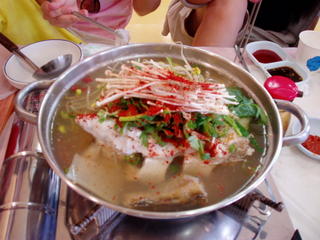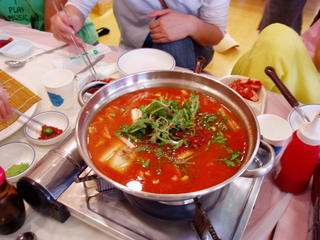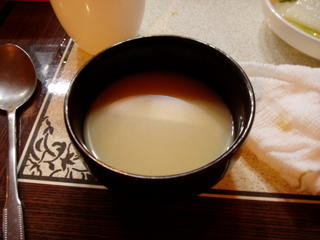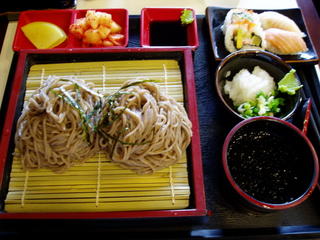Well...Josh is in the other room watching TV I think so I've decided to take this time to update this here blog of mine (good English for an English teacher right?). O_o
Today's entry will be the first of many featuring some of the tasty Korean food I've sampled over the last few months I've been here. Aside from a few things here and there almost all of it has been delicious, and much more nutritious than the standard American fare. If you have a Korean restaurant near you back home, I highly suggest you check it out.
And so we begin with different pics of street vendors (including the korean pancake vendors--as requested), followed by restaurant & take-out food . Yum...

pancake vendor #1

pancake vendor #2

pancake vendor #3

roasted corn vendor

beef & vegetable-topped rice with udon & various side dishes

songpyeong(traditional Korean rice cakes)

whole wheat red bean-stuffed mandu

kimbap

chicken & kimchi fried rice

spicy fish soup

spicy seafood soup

savory rice soup

rice and ginseng-stuffed chicken

Korean rice wine

assorted kimchi & side dishes

kimchi & Korean pancake

sundubu (spicy tofu stew), rice & side dishes

cream cheese-filled pancake

bulgogi, sweet & sour chicken, rice, seaweed soup & side dishes

pork & vegetable mandu & kimchi

potbingsu (Korean snow-cone sundae)

ddeok (rice cake stuffed with sweet red bean paste)

pork cutlet, udon, rice & kimchi

soba (cold buckwheat noodles), sushi & kimchi

hot pot bibimbap & assorted side dishes



























5 Comments:
UMMM! I love Korean BBQ.. I know that isnt too adventurous and all... but ummm!
The bad thing is that I was looking at this post at 2 in the morning last night at Gary's house, blitzed out of my skull, with the munchies and thought it was a good idea to pester Gary and Matthew about how it would be pure genius to find a 24 hour Korean resturant after seeing this...
Thanks for posting those pancake vendor pics! MMMMMM, korean pancakes. Those things sell for $1 each in Los Angeles Koreatown and just don't seem to taste as good as I remember them.
Korea.net kimchi recipe
Contrary to a cool reception at home in the wake of a recent ruckus of its tarnished image, kimchi is gaining popularity with Americans and other places abroad following a spate of news reports to the effect that the traditional Korean dish has an inherent preventative effect on bird flu, the fear of which is now gripping the world.
It was last March that kimchi's curative effect on avian influenza began to be known well outside of the country, when the British public broadcaster BBC aired the results of a research team led by Seoul National University professor Kang Sa-wook.
Quoting the team's test results, BBC said of the 13 chickens stricken with the influenza, 11 had shown telling curative effects after being administered kimchi extracts.
Back in 2003, when the severe acute respiratory syndrome (SARS) broke out in Asia, there was a ‘kimchi rage' in China and Southeast Asia on the strength of reports that the Korea-originated pickle was working in heading off the epidemic.
In recent weeks, the American media were into handling kimchi's efficacy in treating avian flu.
The ABC network, South Carolina's largest state newspaper, the Murtle Beach Sun News, Centre Daily Times of Pennsylvania, and some 100 media outlets across the United States reported kimchi's curative effects on the epidemic.
The ABC reported on Tuesday that with the interest in kimchi growing in America, sauerkraut, the U.S. version of kimchi, is also enjoying a boom. Sauerkraut, a pickle of German origin made from shredded cabbage fermented in brine, is normally inserted into hot dogs or sandwiches.
Journal Times, a publication from Racine, Wisconsin, reported scientists speculated that the bacteria which were detected in kimchi, help cure avian influenza, adding that the same strains were also discovered in sauerkraut.
Kim Jae-soo, the agricultural attaché to the Korean embassy in Washington, D.C., said that contrary to the perception of misgivings Koreans have at home, the American press has given an intense coverage of kimchi's curative effects on the poultry epidemic.
He noted that although the U.S. media had not paid significant attention to kimchi when it gained popularity as a curative to SARS in Southeast Asia, it is watching carefully this time around.
Meanwhile, according to the Ministry of Agriculture and Forestry and the Korea Agro-Trade Corp. on Thursday (Nov. 10), despite the recent unsavory episode involving tainted kimchi, Korea's exports of the item amounted to 26,275 tons in the first 10 months of the year, up 81 tons from a year earlier.
In particular, shipments to Taiwan, Hong Kong and Malaysia have surged partly due to Hallyu, or the Korean cultural wave, prompted by Daejanggeum, a Korean TV drama aired in those countries. In the January-October period, exports to Taiwan totaled 561 tons, up 72 percent from a year before. Hong Kong and Malaysia saw their imports increase by 15 and 150 percent respectively.
Besides, prospects for suspended kimchi shipments to Japan to resume were bright as the Japanese authorities were about to end their investigation into the Korean products soon. About 93 percent of Korea's total exports of 34,827 tons last year went to Japan.
Korea.net korean food recipe
Contrary to a cool reception at home in the wake of a recent ruckus of its tarnished image, kimchi is gaining popularity with Americans and other places abroad following a spate of news reports to the effect that the traditional Korean dish has an inherent preventative effect on bird flu, the fear of which is now gripping the world.
It was last March that kimchi's curative effect on avian influenza began to be known well outside of the country, when the British public broadcaster BBC aired the results of a research team led by Seoul National University professor Kang Sa-wook.
Quoting the team's test results, BBC said of the 13 chickens stricken with the influenza, 11 had shown telling curative effects after being administered kimchi extracts.
Back in 2003, when the severe acute respiratory syndrome (SARS) broke out in Asia, there was a ‘kimchi rage' in China and Southeast Asia on the strength of reports that the Korea-originated pickle was working in heading off the epidemic.
In recent weeks, the American media were into handling kimchi's efficacy in treating avian flu.
The ABC network, South Carolina's largest state newspaper, the Murtle Beach Sun News, Centre Daily Times of Pennsylvania, and some 100 media outlets across the United States reported kimchi's curative effects on the epidemic.
The ABC reported on Tuesday that with the interest in kimchi growing in America, sauerkraut, the U.S. version of kimchi, is also enjoying a boom. Sauerkraut, a pickle of German origin made from shredded cabbage fermented in brine, is normally inserted into hot dogs or sandwiches.
Journal Times, a publication from Racine, Wisconsin, reported scientists speculated that the bacteria which were detected in kimchi, help cure avian influenza, adding that the same strains were also discovered in sauerkraut.
Kim Jae-soo, the agricultural attaché to the Korean embassy in Washington, D.C., said that contrary to the perception of misgivings Koreans have at home, the American press has given an intense coverage of kimchi's curative effects on the poultry epidemic.
He noted that although the U.S. media had not paid significant attention to kimchi when it gained popularity as a curative to SARS in Southeast Asia, it is watching carefully this time around.
Meanwhile, according to the Ministry of Agriculture and Forestry and the Korea Agro-Trade Corp. on Thursday (Nov. 10), despite the recent unsavory episode involving tainted kimchi, Korea's exports of the item amounted to 26,275 tons in the first 10 months of the year, up 81 tons from a year earlier.
In particular, shipments to Taiwan, Hong Kong and Malaysia have surged partly due to Hallyu, or the Korean cultural wave, prompted by Daejanggeum, a Korean TV drama aired in those countries. In the January-October period, exports to Taiwan totaled 561 tons, up 72 percent from a year before. Hong Kong and Malaysia saw their imports increase by 15 and 150 percent respectively.
Besides, prospects for suspended kimchi shipments to Japan to resume were bright as the Japanese authorities were about to end their investigation into the Korean products soon. About 93 percent of Korea's total exports of 34,827 tons last year went to Japan.
Post a Comment
Subscribe to Post Comments [Atom]
<< Home